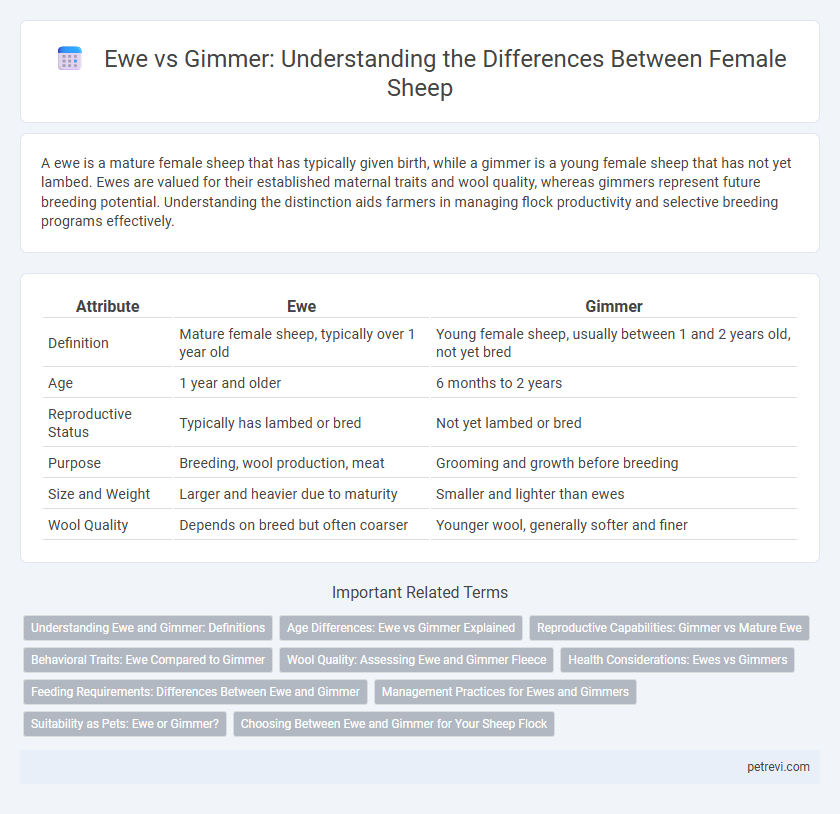A ewe is a mature female sheep that has typically given birth, while a gimmer is a young female sheep that has not yet lambed. Ewes are valued for their established maternal traits and wool quality, whereas gimmers represent future breeding potential. Understanding the distinction aids farmers in managing flock productivity and selective breeding programs effectively.
Table of Comparison
| Attribute | Ewe | Gimmer |
|---|---|---|
| Definition | Mature female sheep, typically over 1 year old | Young female sheep, usually between 1 and 2 years old, not yet bred |
| Age | 1 year and older | 6 months to 2 years |
| Reproductive Status | Typically has lambed or bred | Not yet lambed or bred |
| Purpose | Breeding, wool production, meat | Grooming and growth before breeding |
| Size and Weight | Larger and heavier due to maturity | Smaller and lighter than ewes |
| Wool Quality | Depends on breed but often coarser | Younger wool, generally softer and finer |
Understanding Ewe and Gimmer: Definitions
A ewe is a mature female sheep typically over one year old, used primarily for breeding and wool production. A gimmer refers to a young female sheep between weaning and her first breeding, often under one year of age. Understanding these definitions helps in managing sheep flocks effectively by distinguishing age and reproductive status.
Age Differences: Ewe vs Gimmer Explained
A ewe is a mature female sheep typically over one year old, fully grown and capable of breeding, while a gimmer refers to a young female sheep between six months to one year old that has not yet bred. Ewes have reached reproductive maturity and contribute to flock lamb production, whereas gimmers are often raised until they are mature enough to join the breeding herd. Understanding the age differences between ewes and gimmers is crucial for effective flock management and selective breeding programs.
Reproductive Capabilities: Gimmer vs Mature Ewe
Gimmers are young female sheep that have not yet lambed, typically between 6 months to 1 year old, and represent potential future reproductive capacity. Mature ewes, usually over one year old and having had at least one lambing cycle, exhibit proven fertility and established maternal instincts. Reproductive performance in mature ewes often surpasses that of gimmers due to physiological maturity, higher conception rates, and experienced lambing behaviors.
Behavioral Traits: Ewe Compared to Gimmer
Ewes exhibit well-established maternal instincts, often becoming highly protective and nurturing towards their lambs, which supports better lamb survival rates. Gimmers, as young female sheep yet to have their first lamb, tend to display more exploratory and less cautious behavior, showing curiosity but less attachment to offspring. Behavioral differences highlight ewes' experienced, calm demeanor versus gimmers' youthful restlessness and social learning phase.
Wool Quality: Assessing Ewe and Gimmer Fleece
Ewe fleece typically exhibits higher wool density and staple length compared to gimmer fleece, which is still developing in younger females. Ewe wool often shows superior fiber uniformity and crimp, enhancing its spinnability and market value. Gimmers produce softer but less consistent wool due to their ongoing maturation, influencing fleece weight and quality assessment in breeding programs.
Health Considerations: Ewes vs Gimmers
Ewes, being mature female sheep, often have stronger immune systems compared to gimmers, which are young females that have yet to lamb for the first time. Gimmers require careful health monitoring as they are more susceptible to nutritional deficiencies and stress-related illnesses during growth and pregnancy onset. Proper vaccination and parasite control protocols tailored to ewes and gimmers greatly reduce risks of mastitis and reproductive diseases, ensuring optimal flock health.
Feeding Requirements: Differences Between Ewe and Gimmer
Ewes require higher nutrient intake than gimmers due to pregnancy and lactation demands, necessitating increased protein, energy, and mineral supplementation. Gimmers, being non-lactating and younger, need balanced feed focused on growth and maintenance without the elevated nutrient density required by ewes. Proper feeding strategies ensure optimal health, reproductive performance, and growth rates for each category.
Management Practices for Ewes and Gimmers
Ewes, mature female sheep typically over one year old, require focused nutritional management to maintain optimal body condition for breeding and lambing, while gimmers, young female sheep yet to lamb, need careful monitoring to support growth alongside reproductive development. Ensuring proper vaccination schedules, parasite control, and tailored feeding regimes helps maximize reproductive efficiency and overall flock health in both ewes and gimmers. Differentiated handling in terms of housing and stress minimization can reduce health risks and improve future productivity in gimmers compared to established ewes.
Suitability as Pets: Ewe or Gimmer?
Ewes, mature female sheep typically over one year old, exhibit calm temperaments and strong maternal instincts, making them suitable for pet owners seeking a gentle, nurturing companion. Gimmers, young female sheep under one year old that have not yet bred, are often more energetic and curious, appealing to those wanting an active and playful pet. Choosing between a ewe and a gimmer depends on the desired interaction level, with ewes offering stability and gimmers providing liveliness.
Choosing Between Ewe and Gimmer for Your Sheep Flock
Selecting between a ewe and a gimmer for your sheep flock hinges on age, reproductive status, and productivity goals. A ewe, typically a mature female that has lambed, offers proven fertility and established maternal skills, ensuring consistent flock growth. In contrast, a gimmer--an immature female yet to lamb--provides potential for future breeding but demands more time before contributing to lamb production.
Ewe vs Gimmer for Sheep Female Infographic

 petrevi.com
petrevi.com